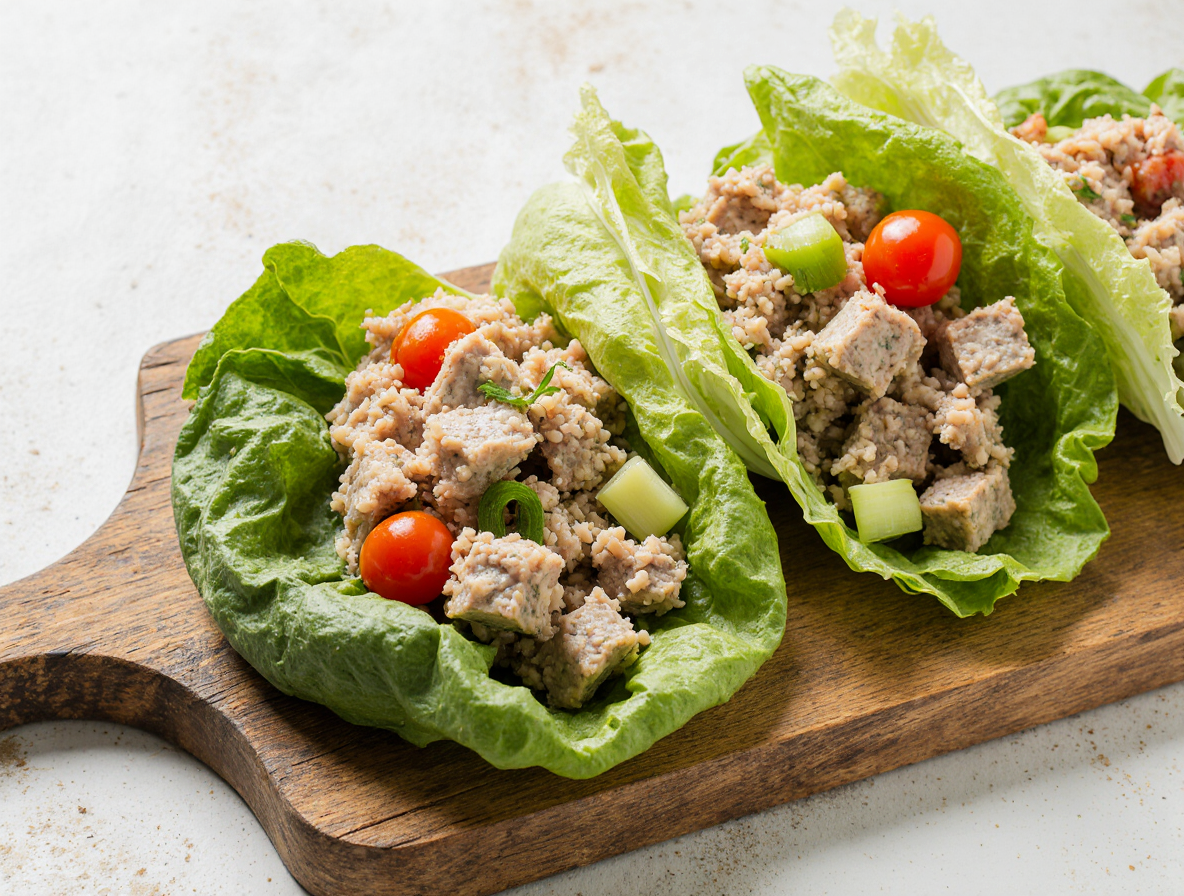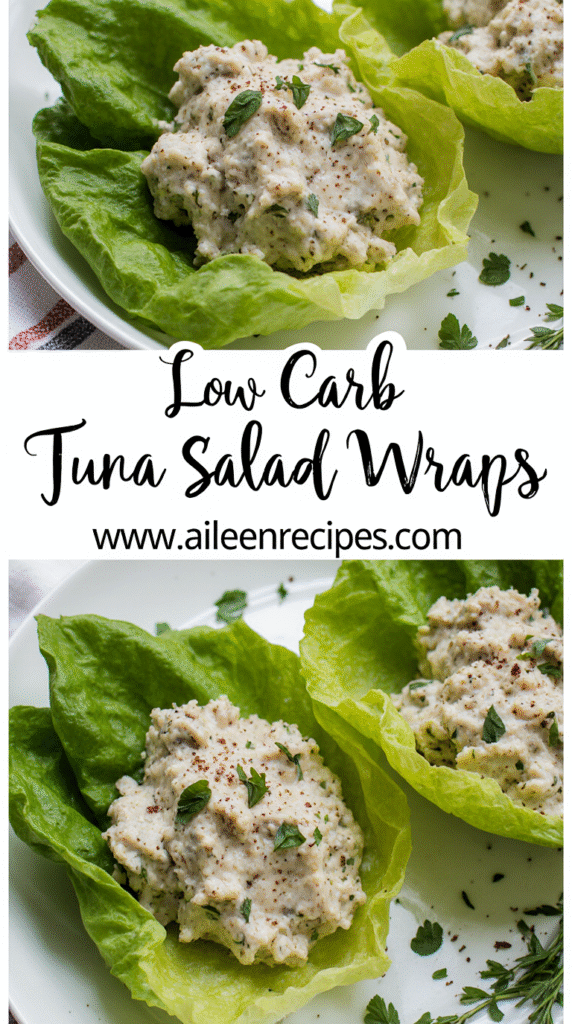How to Make Tuna Salad Lettuce Wraps: A 10-Minute Low-Carb Lunch Guide
Did you know that tuna salad lettuce wraps contain only about 4 net carbs per wrap?
For anyone looking for a protein-packed meal without the carb overload, this is a game-changer. We’ve discovered that these wraps are not just low in carbs but also incredibly satisfying. A serving of three wraps contains under 200 calories while delivering an impressive 17 grams of protein, making them perfect for a healthy lunch option.
What makes these tuna lettuce wraps particularly appealing is their simplicity. This no-cook meal is quick to prepare and ideal for busy weekdays. Actually, you can whip up this low carb tuna salad in just a few minutes, giving you more time to enjoy your lunch break or tackle other tasks.
Throughout this guide, we’ll show you exactly how to create the perfect healthy tuna lettuce wraps with step-by-step instructions. From selecting the right ingredients to customizing flavors and storing leftovers, we’ve got you covered with everything you need for this 10-minute meal solution. Let’s dive in and transform your lunch routine!
Choose the Right Ingredients
Selecting quality ingredients makes all the difference when creating delicious tuna salad lettuce wraps. The right combination of tuna, fresh vegetables, and flavorful add-ins transforms a simple lunch into something extraordinary.
Best type of canned tuna to use
When shopping for tuna, quality matters significantly. Solid albacore white tuna generally offers the best flavor and texture for tuna lettuce wraps, as opposed to chunk light varieties which can be more fishy-tasting and have a mushier consistency. According to taste tests, Wild Planet Skipjack Wild Tuna ranks highest for flavor and texture. Other highly rated options include Whole Foods’ 365 brand and Target’s Good & Gather chunk light tuna.
Consider the packing medium as well. Water-packed tuna has a leaner, flakier texture that works wonderfully for classic mayo-based tuna salad. Alternatively, tuna packed in olive oil provides richer flavor—brands like Genova’s albacore tuna are especially recommended for their fresher taste.
For those concerned about sustainability, look for pole and line caught tuna with traceable sourcing, or brands like Safe Catch that test for mercury levels.
Fresh veggies that add crunch and flavor
Fresh vegetables enhance both texture and nutrition in your tuna salad lettuce wraps:
- Celery: Provides essential crunch and is mentioned in nearly all recipes
- Red onion: Adds sharp flavor (substitute green onions or shallots for milder taste)
- Bell peppers: Contribute sweetness, vibrant color, and satisfying texture
- Cucumber: Offers refreshing crispness without watering down the mixture
For the wrap itself, butter lettuce (Boston or Bibb varieties) works beautifully with its soft, tender leaves. Romaine and iceberg are excellent alternatives if you prefer more structural support.
Optional add-ins for extra taste
Elevate your tuna salad lettuce wraps with these flavorful additions:
Dill pickle relish or chopped pickles provide tanginess that complements tuna perfectly. Furthermore, ingredients like capers, fresh herbs (dill, parsley, or basil), and citrus (lemon juice or zest) brighten the overall flavor profile.
For creaminess, avocado works as both a mayo alternative and nutritious addition. Those looking to increase protein can incorporate hard-boiled eggs or even chickpeas.
Spice lovers might enjoy adding jalapeños, Sriracha, or curry powder for an unexpected twist. Consequently, these additions transform a basic tuna salad into a customized meal that suits your personal preferences.
How to Make Tuna Salad Lettuce Wraps
Creating delicious tuna salad lettuce wraps starts with proper preparation techniques. Let’s break down this simple process into steps that ensure your healthy tuna lettuce wraps come out perfectly every time.
Drain and prep the tuna
Proper draining is the foundation of excellent tuna lettuce wraps. Begin by opening your tuna can and thoroughly draining the liquid. For best results, place the tuna in a fine-mesh strainer over the sink, then press down to remove excess moisture. Many chefs even recommend patting the tuna dry with paper towels to prevent a watery salad. Once drained, transfer the tuna to a medium-sized mixing bowl and use a fork to flake it to your desired consistency.
Mix the dressing and combine with tuna
Next, prepare your dressing before adding it to the tuna. In a separate bowl, combine mayonnaise, Dijon mustard, and lemon juice as your base. Alternatively, you could use a mixture of Greek yogurt and mayo for a lighter option. Add seasonings like salt, pepper, and fresh herbs such as dill or parsley.
Once your dressing is ready, pour it over the flaked tuna and mix thoroughly with a fork, ensuring all ingredients are well distributed. Then fold in your prepared vegetables – celery, red onion, and any additional mix-ins like capers or pickle relish. Stir until everything is evenly combined, adjusting seasoning if needed.
Prepare and fill the lettuce leaves
Initially, select your lettuce leaves – butter lettuce, romaine, or iceberg all work well. Remove the leaves carefully from the head, wash them thoroughly, and pat dry with paper towels. For sturdy wraps, trim off the stiff white stem using kitchen scissors.
Finally, spoon approximately two tablespoons of tuna mixture into each lettuce leaf. For easier eating, place the filling toward the bottom third of the leaf. Some recipes recommend adding garnishes like cherry tomatoes or avocado slices right before serving. These healthy tuna lettuce wraps can be enjoyed immediately, offering a satisfying low-carb tuna salad option that’s ready in minutes.
Customize Your Tuna Lettuce Wraps
The true beauty of tuna salad lettuce wraps lies in their versatility. Once you’ve mastered the basic recipe, customization options are nearly endless.
Low-carb swaps and substitutions
Not a fan of mayo? Several alternatives can keep your tuna lettuce wraps deliciously low-carb. Greek yogurt makes an excellent substitute, adding extra protein while maintaining creaminess. Alternatively, try replacing half or all of the mayo with mashed avocado for healthy fats and rich texture.
For a completely different approach, skip the creamy base entirely and opt for 2 tablespoons of olive oil with 2 tablespoons of wine vinegar instead. Hummus offers yet another creative alternative that pairs wonderfully with tuna.
Add-ins like avocado, tomatoes, or herbs
Elevate your tuna salad lettuce wraps with these flavorful additions:
- Vegetables: Diced cucumber (remove seeds first to prevent sogginess), matchstick carrots, water chestnuts for extra crunch, or bell peppers
- Protein boosters: Hard-boiled eggs or sliced almonds add satisfying texture and nutrition
- Briny elements: Green olives, capers, or dill pickles provide tangy contrast
- Fresh herbs: Dill, parsley, or cilantro brighten the overall flavor profile
Remember that watery vegetables like cucumbers can make the salad soggy over time, so add these right before serving.
Make it spicy or tangy with seasoning tweaks
Moreover, simple seasoning adjustments can transform your tuna lettuce wraps entirely. For heat lovers, incorporate sriracha sauce (start with 1 teaspoon), chili flakes, or finely diced hot green pickled peppers[173].
Prefer tangier flavors? Add a splash of pickle brine or fresh lemon juice. Garlic (either minced fresh or as powder) contributes an interesting flavor dimension. Dijon mustard or whole grain mustard varieties provide both tang and texture.
Season cautiously, tasting as you go. With these simple tweaks, your healthy tuna lettuce wraps can match any flavor preference while staying perfectly low-carb.
Storage and Meal Prep Tips
Proper storage practices extend the enjoyment of your tuna salad lettuce wraps beyond a single meal. Throughout this section, we’ll explore how to maximize freshness for all components.
How long tuna salad lasts in the fridge
Properly stored tuna salad remains safe to eat for 3-4 days in the refrigerator. Nonetheless, ensure it’s refrigerated within 2 hours of preparation (or 1 hour if temperature exceeds 90°F) to prevent bacterial growth. Use airtight glass containers rather than bowls with plastic wrap for optimal freshness. Additionally, label containers with preparation dates to track freshness.
How to store lettuce separately for freshness
Lettuce requires different storage techniques to maintain crispness. The paper towel method works remarkably well—simply layer leaves between paper towels, roll them up, place in a plastic bag, and refrigerate for 7-10 days of freshness. Alternatively, wrap individual romaine hearts tightly in aluminum foil, which can preserve them for up to 30 days. For butter lettuce, store unwashed in the coldest part of your refrigerator.
Tips for prepping ahead for the week
Prepare components separately for maximum freshness. Store washed, dried romaine leaves in containers with paper towels. Mix tuna salad and keep it refrigerated in sealed containers. Subsequently, assemble your low carb tuna salad wraps immediately before eating to ensure optimal texture and taste. This approach provides a quick, healthy meal solution throughout your busy week.
Conclusion
Tuna salad lettuce wraps truly offer a perfect solution for anyone seeking a nutritious, low-carb meal option without sacrificing flavor or satisfaction. These protein-packed wraps deliver impressive nutritional benefits while requiring minimal preparation time – a winning combination for busy weekdays.
We’ve explored numerous ways to elevate your tuna lettuce wraps, from selecting high-quality tuna varieties to incorporating crunchy vegetables and flavorful add-ins. Additionally, the customization options allow you to adapt this versatile dish to suit your personal taste preferences, whether you prefer creamy, tangy, or spicy flavor profiles.
Meal prep enthusiasts will certainly appreciate how these wraps can fit into a weekly routine. Simply store your tuna mixture separately from the lettuce leaves, then assemble right before eating for maximum freshness and crunch. Therefore, you’ll always have a quick, healthy meal ready when hunger strikes.
These wraps prove that healthy eating doesn’t need to be complicated or time-consuming. Rather than spending precious minutes preparing elaborate meals, you can enjoy this protein-rich, low-carb option in just 10 minutes. Most importantly, these wraps demonstrate that nutritious food can be both convenient and delicious.
Next time you’re looking for a quick lunch that won’t derail your healthy eating goals, remember these tuna salad lettuce wraps. Your body will thank you for the protein boost, while your taste buds will appreciate the satisfying flavors and textures. Give this 10-minute meal a try – it might just become your new lunchtime favorite!
FAQs
Q1. How do I make tuna salad lettuce wraps? Drain canned tuna and mix it with mayonnaise, diced onion, salt, and pepper in a bowl. Lay out lettuce leaves, divide the tuna mixture among them, and sprinkle with cheese if desired. Roll up the leaves to create wraps.
Q2. Are tuna lettuce wraps a healthy meal option? Yes, tuna lettuce wraps are a healthy choice. They’re low in carbs and calories while being high in protein. A serving of three wraps typically contains under 200 calories, 17 grams of protein, and only 4 grams of net carbs, making them ideal for a nutritious lunch or meal prep.
Q3. What are some ways to customize tuna lettuce wraps? You can customize your wraps by adding ingredients like diced cucumber, cherry tomatoes, or avocado slices. For extra flavor, try incorporating herbs like dill or parsley, or add a kick with jalapeños or hot sauce. You can also swap mayonnaise for Greek yogurt or mashed avocado for a different twist.
Q4. How long can I store tuna salad in the refrigerator? Properly stored tuna salad can last in the refrigerator for 3-4 days. Make sure to refrigerate it within 2 hours of preparation (or 1 hour if the temperature is above 90°F) and store it in an airtight container for best results.
Q5. What’s the best way to prep tuna lettuce wraps for the week? For meal prepping, store the tuna salad mixture and lettuce leaves separately. Keep the tuna salad in a sealed container in the fridge, and wrap the washed and dried lettuce leaves in paper towels before placing them in a plastic bag. Assemble the wraps just before eating to maintain freshness and crispness.


